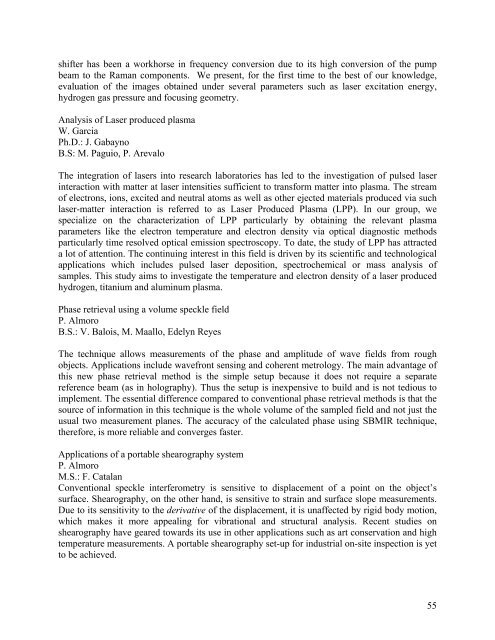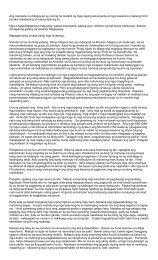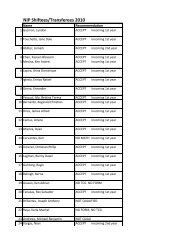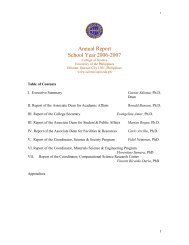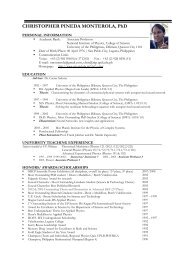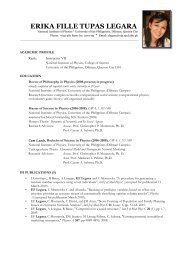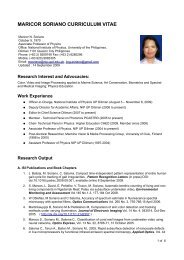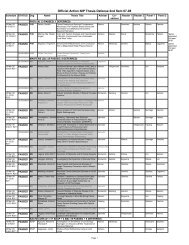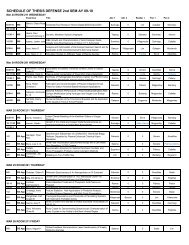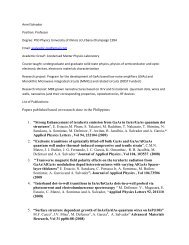NIP REPORT January 2006- May 2007 - The UP College of Science ...
NIP REPORT January 2006- May 2007 - The UP College of Science ...
NIP REPORT January 2006- May 2007 - The UP College of Science ...
Create successful ePaper yourself
Turn your PDF publications into a flip-book with our unique Google optimized e-Paper software.
shifter has been a workhorse in frequency conversion due to its high conversion <strong>of</strong> the pump<br />
beam to the Raman components. We present, for the first time to the best <strong>of</strong> our knowledge,<br />
evaluation <strong>of</strong> the images obtained under several parameters such as laser excitation energy,<br />
hydrogen gas pressure and focusing geometry.<br />
Analysis <strong>of</strong> Laser produced plasma<br />
W. Garcia<br />
Ph.D.: J. Gabayno<br />
B.S: M. Paguio, P. Arevalo<br />
<strong>The</strong> integration <strong>of</strong> lasers into research laboratories has led to the investigation <strong>of</strong> pulsed laser<br />
interaction with matter at laser intensities sufficient to transform matter into plasma. <strong>The</strong> stream<br />
<strong>of</strong> electrons, ions, excited and neutral atoms as well as other ejected materials produced via such<br />
laser-matter interaction is referred to as Laser Produced Plasma (LPP). In our group, we<br />
specialize on the characterization <strong>of</strong> LPP particularly by obtaining the relevant plasma<br />
parameters like the electron temperature and electron density via optical diagnostic methods<br />
particularly time resolved optical emission spectroscopy. To date, the study <strong>of</strong> LPP has attracted<br />
a lot <strong>of</strong> attention. <strong>The</strong> continuing interest in this field is driven by its scientific and technological<br />
applications which includes pulsed laser deposition, spectrochemical or mass analysis <strong>of</strong><br />
samples. This study aims to investigate the temperature and electron density <strong>of</strong> a laser produced<br />
hydrogen, titanium and aluminum plasma.<br />
Phase retrieval using a volume speckle field<br />
P. Almoro<br />
B.S.: V. Balois, M. Maallo, Edelyn Reyes<br />
<strong>The</strong> technique allows measurements <strong>of</strong> the phase and amplitude <strong>of</strong> wave fields from rough<br />
objects. Applications include wavefront sensing and coherent metrology. <strong>The</strong> main advantage <strong>of</strong><br />
this new phase retrieval method is the simple setup because it does not require a separate<br />
reference beam (as in holography). Thus the setup is inexpensive to build and is not tedious to<br />
implement. <strong>The</strong> essential difference compared to conventional phase retrieval methods is that the<br />
source <strong>of</strong> information in this technique is the whole volume <strong>of</strong> the sampled field and not just the<br />
usual two measurement planes. <strong>The</strong> accuracy <strong>of</strong> the calculated phase using SBMIR technique,<br />
therefore, is more reliable and converges faster.<br />
Applications <strong>of</strong> a portable shearography system<br />
P. Almoro<br />
M.S.: F. Catalan<br />
Conventional speckle interferometry is sensitive to displacement <strong>of</strong> a point on the object’s<br />
surface. Shearography, on the other hand, is sensitive to strain and surface slope measurements.<br />
Due to its sensitivity to the derivative <strong>of</strong> the displacement, it is unaffected by rigid body motion,<br />
which makes it more appealing for vibrational and structural analysis. Recent studies on<br />
shearography have geared towards its use in other applications such as art conservation and high<br />
temperature measurements. A portable shearography set-up for industrial on-site inspection is yet<br />
to be achieved.<br />
55


